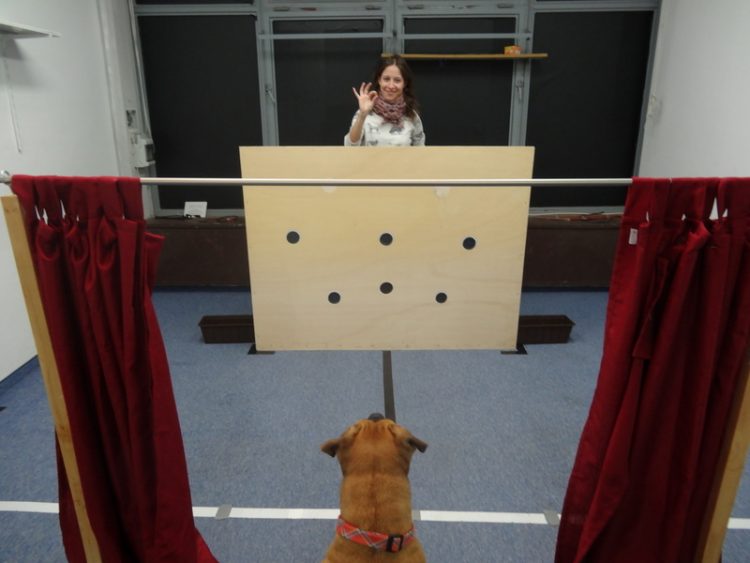Dogs follow human voice direction to find hidden food

In this experiment, the dogs know that food is hidden in one of these boxes - but they don't know in which one. To find the tasty snack, they are following the human voice. © MPI f. Evolutionary Anthropology
Dogs and puppies are gifted at interpreting human communicative hints, and previous studies showed that they use human visual cues like pointing or gazing in order to find hidden food. Researchers of the Max Planck Institute for Evolutionary Anthropology in Leipzig, Germany, have now studied for the first time whether dogs can locate hidden food by relying on auditory information alone.
In an experimental setting, an experimenter went behind a barrier and presented adult dogs and puppies with two identical boxes, but only one of them contained food. From behind the barrier, hidden from the dog’s sight, the experimenter vocalized excitedly while looking towards the box containing food. Most adult dogs and socialized puppies successfully followed the direction of the experimenter’s voice to the food source; the puppies even beat the adult dogs in this task.
The researchers conclude that dogs do not rely on visual cues only, but on a combination of human communicative hints. These social skills may have become part of the dog’s genetic make-up during domestication.
Dogs and puppies are particularly skilled in using human communicative cues like pointing or gazing, especially when it comes to locating hidden food. Wolves, dogs’ closest relative, and chimpanzees on the other hand are unable to use these cues to the same end.
Recent studies explored the ability of children and chimpanzees to follow human voice direction to a target, like a toy or food item, and found that while 1-year-old children succeeded, chimpanzees did not. In their current study Federico Rossano and colleagues have now investigated for the first time whether adult dogs and dog puppies are capable of this as well.
The researchers placed a large wooden barrier in the room and used two identical containers for hiding the food. After showing the food to the dog, the experimenter closed a curtain, hid the food in one of the boxes and opened the curtain again: Both containers were now visible to the dog. The experimenter then sat down behind the barrier facing the box with the food reward and expressed her excitement verbally. The experimenter then released the dog so he could choose one of the containers.
“Most of the dogs successfully and repeatedly followed the experimenter’s voice direction to find the hidden food”, says Rossano. “They performed as well in this task – if not better – than human infants.” In a follow up study the researchers ruled out the possibility that dogs could locate the hidden food just via smell.
In a second part of the study puppies of eight to 14 weeks of age took part in the same test. While some of these puppies had interacted with humans regularly, others had had little contact to humans. “The puppies, too, were able to use the human’s voice direction to find the hidden food”, says Rossano. “Interestingly, the group of normally socialized puppies even outperformed the adult dogs while the ones with little contact with humans performed at chance level.”
The results of these studies show that dogs and puppies use several human communicative cues or a combination of them in flexible ways to find hidden food, and that they learn these skills very quickly once they get in touch with humans. “Dogs may have been selected for their ability to pay special attention to humans”, says Rossano. “This set of social skills may have become part of their genetic repertoire”.
Contact
Dr. Federico Rossano
Max Planck Institute for Evolutionary Anthropology, Leipzig
Phone: +49 341 3550-430
Sandra Jacob
Press and Public Relations
Max Planck Institute for Evolutionary Anthropology, Leipzig
Phone: +49 341 3550-122
Media Contact
All latest news from the category: Life Sciences and Chemistry
Articles and reports from the Life Sciences and chemistry area deal with applied and basic research into modern biology, chemistry and human medicine.
Valuable information can be found on a range of life sciences fields including bacteriology, biochemistry, bionics, bioinformatics, biophysics, biotechnology, genetics, geobotany, human biology, marine biology, microbiology, molecular biology, cellular biology, zoology, bioinorganic chemistry, microchemistry and environmental chemistry.
Newest articles

Silicon Carbide Innovation Alliance to drive industrial-scale semiconductor work
Known for its ability to withstand extreme environments and high voltages, silicon carbide (SiC) is a semiconducting material made up of silicon and carbon atoms arranged into crystals that is…

New SPECT/CT technique shows impressive biomarker identification
…offers increased access for prostate cancer patients. A novel SPECT/CT acquisition method can accurately detect radiopharmaceutical biodistribution in a convenient manner for prostate cancer patients, opening the door for more…

How 3D printers can give robots a soft touch
Soft skin coverings and touch sensors have emerged as a promising feature for robots that are both safer and more intuitive for human interaction, but they are expensive and difficult…





















